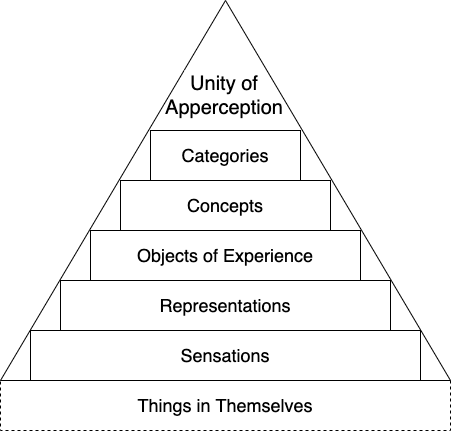|
Getting your Trinity Audio player ready...
|

When reading Critique of Pure Reason, I get the sense that Kant has a penchant for visualization and architecture, so it seems appropriate to represent his system of Reason, as I understand it, with a diagram (shown above). Although I’m using his own terms (translated from German into English), I cannot be certain that I understand them the same way Kant does, partly because he has decided not do define his terms, partly because of his notoriously bad writing style. Nevertheless, this should not stop me or anyone from critiquing Kant’s system, not as it is in itself, but as it appears to the critic, for as Kant himself argues, appearance is all that matters.
First and foremost, where (or what) is truth in the whole Kantian architecture of reason? Truth is commonly defined or understood as a correspondence between our concept of an object, and the object in itself. By contrast, Kant asserts that we cannot know the object in itself, and re-defines “objective truth” as a correspondence between “concepts” on one side, and “objects of experience” on the other, both of which are subjective in the sense that they exist in our consciousness only.
Second, the Kantian architecture of reason is built upon and limited to sensations only, which is also why he denies any knowledge not grounded in sensation. This is contrary to the notion of intelligible in the philosophy of Plato and Aristotle. For example, justice and virtue are not sensible, that is, having no dimensions and cannot be represented by magnitudes, but they are intelligible, that is, understood by the intellect. Given that moral philosophy of the ancient Greeks has acknowledged the reality of the intelligible, and has been devoted to the pursuit of them, Kant’s failure to include them in his “complete” system of reason is regrettable.
Third, the way Kant “proves” that we cannot know things apart from the senses is also problematic. He tends to describe how he himself would think of, i.e., visualize, something, and if he cannot visualize it, he would proclaim the thing cannot be thought/known. For a prime example, to prove that we cannot know ourselves as we are in ourselves, Kant argues thus: first, our inner sense of self is always grounded in time, and time is the form of appearances of things, therefore we know ourselves only as we appear in time, not as we are in ourselves; second, he cannot form any concept of self from his inner sense of himself, and therefore the self (or the soul) cannot be known. Objection to the first argument: from the fact that a thing is known in time it doesn’t follow that the thing itself is grounded in (or bound by) time, nor that the knowledge of the thing is grounded in time. Appearances are bounded by time and change with time, and so are known in time only. But things that don’t change with time can be known in time as well. To use an imperfect analogy, say we happen to meet someone in 2020, it doesn’t mean that the person only lives in 2020, nor that what we learn about the person is only valid for one year. Objection to the second argument: the intelligible are not sensible, so one cannot visualize them in one’s mind as Kant tends to do, but it doesn’t follow that they cannot be known. In fact, philosophers like Plato and Descartes have argued that the soul can be known, precisely because its attributes are intelligible. Kant has failed to address their arguments.
Fourth but not last, Kant’s epistemology is inconsistent with his moral philosophy. Simply put, his epistemology says that we cannot know what is good, but only what appears to be good. If so, then we cannot do good, but only appears to do what appears to be good at a given point in space and time. Kant, the categorical moralist that he is, is not satisfied with this type of morality. He attempts to deal with this problem in the sequel Critique of Practical Reason: Instead of acknowledging the objective reality of Goodness, Kant resorts to Categorical Imperative, that is, demanding universal goodness, as a poor substitute for objective goodness, without acknowledging what goodness consists in.
Related Posts:
References:
- Kant, Immanuel. Critique of Pure Reason. Translated by Norman Kemp Smith. Basingstoke: Palgrave Macmillan, 1929.
